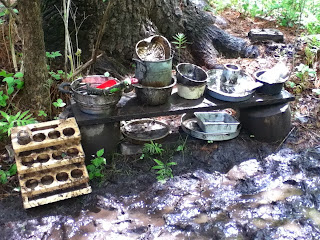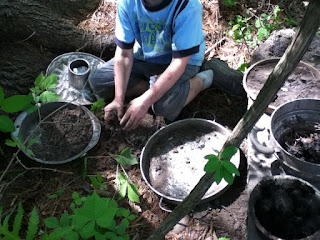 |
| Mud Kitchen at Forest Preschool. |
Squish, splat, plop! During mud season, I often grumble as I slog through thick, and sometimes greasy mud while driving along the back roads of central Vermont. My seven year old daughter, however, absolutely delights in squishing in the mud on our road and stomping in puddles with booted feet, creating mud dams, and redirecting the flow of snow melt. As soon as the snow disappears and the swollen brook subsides, she and all the neighborhood kids spend countless hours in the “mud pot” located on the side of the brook in our village. They step in it, stir it, add water and interesting natural ingredients, make pies, make pottery, and the list goes on and on. At Forest Preschool this spring, mud and puddles were a main attraction.
 |
| Making "eggs" to put in a "nest." |
A child to mud is much like a bear to honey. From a parental perspective, mud and puddles may be something to avoid but to a child, they are shear joy. The allure of playing in the mud, stomping in puddles, and getting covered in dirt is irresistible! Such play may seem like all fun and games but, actually, it’s much more than that.
Mud and puddle play offers rich learning opportunities, ignites imaginations, and builds healthy immune systems. Children are innately drawn to explore the elements of the earth, learning how they behave and what can be done with them. Through mud and puddle play, children learn about cause and effect. They become scientists and artists as they explore and experiment with the chemistry of soil and water, the physics of pouring and the flow of water, and endless creative possibilities that mud and puddles offer.
 |
| Painting with mud! |
On the land at North Branch Nature Center, beside a naturally wet and muddy spot at the edge of the forest, sits a Mud Kitchen. Pots, pans, a spice rack, whisks, shovels, spoons, are assembled for Forest Preschoolers to become scientists, chefs, and artists. Imaginations come alive in the Mud Kitchen and delicacies such as pizza soup, birthday cake, an assortment of pies, are concocted. Mud is at the heart of such domestic and scientific endeavors but a variety of other natural ingredients found in the forest are untilized. Pine needles, stones, cones, sticks, and leaves are often added to recipes and solutions or sprinkled on top to decorate or engage in further experimentation. Earth and water are poured, stirred, and mixed.
 |
| Cooking in the kitchen! |
In the article, Making a Mud Kitchen, Jan White shares, "Making connections through discovering and investigating cause and effect is the stuff of brain development and scientific process. Curiosity, fascination and the pleasure of finding thing out are fundamentally important to the human state - being human.
The processes of making concoctions brings the worlds of science and art completely together through possibility thinking. The growth of imagination and creativity happens through building on concrete cause-and-effect experience to posing and predicting what if? Good scientists do this all the time, as do artists and all other innovators."
 |
| Experimenting with the flow of water and fishing with a stick! |
Mud not only capitalizes on natural curiosity as a tool for teaching and learning, it helps to support healthy immune systems. Jan White also share in the article, Making a Mud Kitchen, “Contact with soil is actually beneficial as the bacteria in it help to build healthy functioning immune systems in young children (See Why Dirt is Good in booklist below), and research also suggests that that this makes us feel happy! (Go play in the dirt). “
At North Branch Nature Center's Forest Preschool, it’s not uncommon to hear a child exclaim, "Mud is glorious.” I had to chuckle one time as a child shared, “I love puddles - I want to sleep in one!" Alas, proof is in the (mud) pudding - earth mixed with water is irresistible!
And so, if you have children or know a child, enjoy time outdoors this season and, as Jan White says, go play in the dirt!
 |
| Mud glorious mud! |
Mud Kitchens are easy to make at home. All you need is a little dirt (purchased topsoil or earth free of cat or dog feces), a little water (even one pot full will do), and some old pots and pans. Check out the link below to learn more!
Link to Making a Mud Kitchen by Jan White:
http://www.muddyfaces.co.uk/mud_kitchens.php/#Delving_Into



